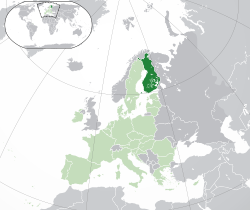
Finland
Country in Northern Europe / From Wikipedia, the free encyclopedia
Dear Wikiwand AI, let's keep it short by simply answering these key questions:
Can you list the top facts and stats about Finland?
Summarize this article for a 10 years old
Finland (Finnish: Suomi [ˈsuo̯mi] ⓘ; Swedish: Finland [ˈfɪ̌nland] ⓘ), officially the Republic of Finland (Finnish: Suomen tasavalta; Swedish: Republiken Finland; listen to allⓘ),[note 2] is a Nordic country in Northern Europe. It borders Sweden to the northwest, Norway to the north, and Russia to the east, with the Gulf of Bothnia to the west and the Gulf of Finland to the south, opposite Estonia. Finland covers an area of 338,145 square kilometres (130,559 sq mi)[5] and has a population of 5.6 million. Helsinki is the capital and largest city. The vast majority of the population are ethnic Finns. Finnish and Swedish are the official languages, with Swedish being the native language of 5.2% of the population.[12] Finland's climate varies from humid continental in the south to boreal in the north. The land cover is predominantly boreal forest biome, with more than 180,000 recorded lakes.[13]
Republic of Finland | |
|---|---|
| Anthem: Maamme (Finnish) Vårt land (Swedish) (English: "Our Land") | |
Location of Finland (dark green) – in Europe (green & dark grey) | |
| Capital and largest city | Helsinki 60°10′15″N 24°56′15″E |
| Official languages | |
| Recognized national languages | |
| Ethnic groups | |
| Religion (2021)[3] |
|
| Demonym(s) | |
| Government | Unitary parliamentary republic[4] |
| Sauli Niinistö | |
| Petteri Orpo | |
| Jussi Halla-aho | |
| Legislature | Parliament |
| Independence from Russia | |
| 29 March 1809 | |
| 6 December 1917 | |
| January – May 1918 | |
| 17 July 1919 | |
| 30 November 1939 – 13 March 1940 | |
| 25 June 1941 – 19 September 1944 | |
| 1 January 1995 | |
• Joined NATO | 4 April 2023 |
| Area | |
• Total | 338,145[5] km2 (130,559 sq mi) (65th) |
• Water (%) | 9.71 (2015)[6] |
| Population | |
• 2023 estimate | |
• Density | 16.4/km2 (42.5/sq mi) (213th) |
| GDP (PPP) | 2022 estimate |
• Total | |
• Per capita | |
| GDP (nominal) | 2022 estimate |
• Total | |
• Per capita | |
| Gini (2021) | low |
| HDI (2021) | very high · 11th |
| Currency | Euro (€) (EUR) |
| Time zone | UTC+2 (EET) |
| UTC+3 (EEST) | |
| Date format | dd.mm.yyyy[11] |
| Driving side | right |
| Calling code | +358 |
| ISO 3166 code | FI |
| Internet TLD | .fi, .axa, .eub |
| |
Finland was first settled around 9000 BC after the last Ice Age.[14] During the Stone Age, various cultures emerged, distinguished by different styles of ceramics. The Bronze Age and Iron Ages were marked by contacts with other cultures in Fennoscandia and the Baltic region.[15] From the late 13th century, Finland became part of Sweden as a result of the Northern Crusades. In 1809, as a result of the Finnish War, Finland became part of the Russian Empire as the autonomous Grand Duchy of Finland. During this period, Finnish art flourished and the idea of independence began to take hold. In 1906, Finland became the first European state to grant universal suffrage, and the first in the world to give all adult citizens the right to run for public office.[16][note 3] Following the Russian Revolution of 1917, Finland declared its independence from Russia. In 1918 the young nation was divided by the Finnish Civil War. During the World War II, Finland fought against the Soviet Union in the Winter War and the Continuation War, and later against Nazi Germany in the Lapland War. As a result, it lost parts of its territory but retained its independence.
Finland remained a largely agricultural country until the 1950s. After World War II, it industrialised quickly and established an advanced economy, with a welfare state built on the Nordic model. This allowed the country to experience overall prosperity and high per capita income.[17] During the Cold War, Finland officially embraced a policy of neutrality. Since then, it has become a member of the European Union in 1995, the Eurozone in 1999, and NATO in 2023. Finland is a member of various international organisations, such as the United Nations, the Nordic Council, the Schengen Area, the Council of Europe, the World Trade Organization, and the Organisation for Economic Co-operation and Development (OECD). The nation performs exceedingly well in national performance metrics, including education, economic competitiveness, civil liberties, quality of life, and human development.[18][19][20][21]


.svg/250px-EU-Finland_(orthographic_projection).svg.png)
